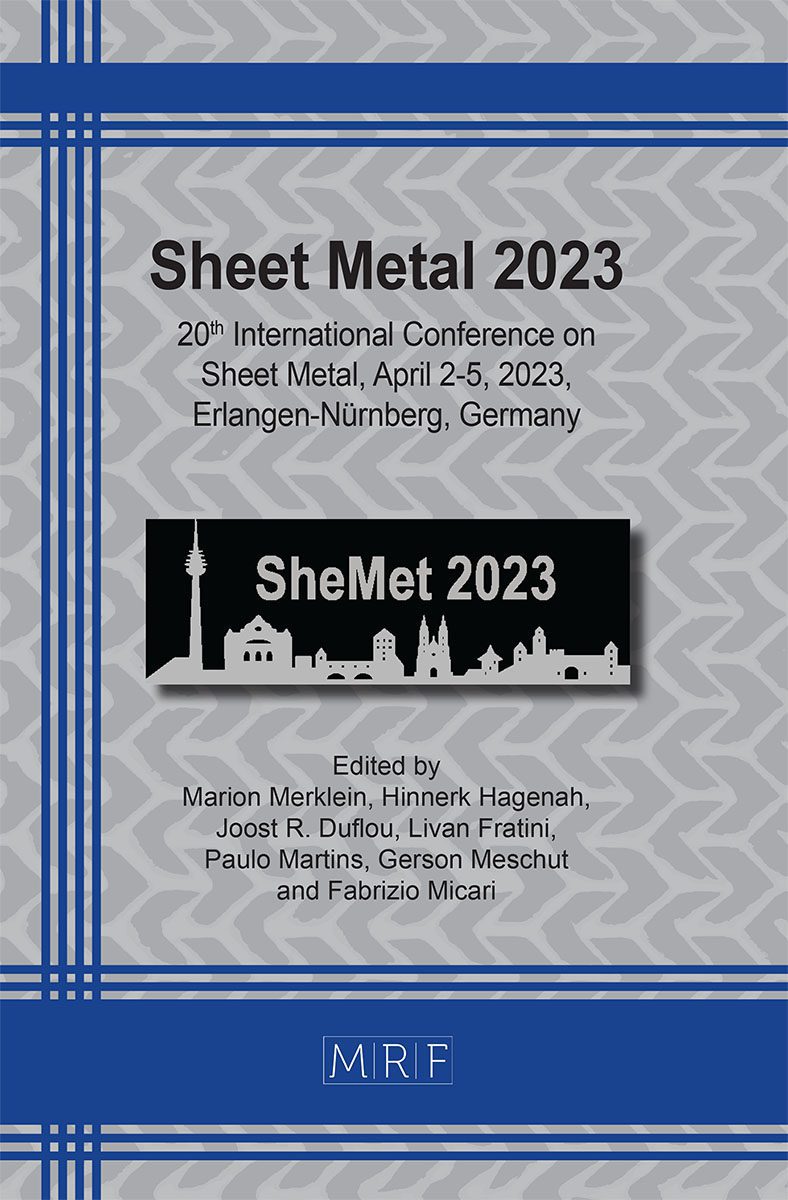Combination of versatile self-piercing riveting processes
Simon Wituschek, Fabian Kappe, Gerson Meschut, Michael Lechner
download PDFAbstract. Due to economic and ecological framework conditions, a resource-saving utilization of raw materials and energy is becoming increasingly important in particular in the mobility sector. For the reduction of moving masses and the resources consumed, lightweight construction technologies are part of modern production processes in vehicle manufacturing, for example in the form of multi-material systems. Challenging in the manufacture of multi-material systems especially in view of changing supply chains is the variety of materials and geometries that bring conventional joining processes to their limits. Therefore, new processes are required, which can react versatile to process and disturbance variables. A widely used industrial joining process is semi-tubular self-piercing riveting, which is however a rigid process. To increase the versatility, the two newly established processes multi-range self-piercing riveting and tumbling self-piercing riveting are combined and the capabilities for targeted material flow control are united. Therefore, an innovative two-stage process based on the combination is introduced in this paper. The rivet is set with the multi-range self-piercing riveting process with an overlap of the rivet head and then formed by a tumbling process. Further, a specific adaptation of the tumbling strategy is used to investigate the possibility of reducing cracks in the rivet head. Thereby, different tumbling strategies are used and similar geometric joint formations are achieved to compare the results.
Keywords
Joining, Material, Manufacturing
Published online 3/17/2023, 8 pages
Copyright © 2023 by the author(s)
Published under license by Materials Research Forum LLC., Millersville PA, USA
Citation: Simon Wituschek, Fabian Kappe, Gerson Meschut, Michael Lechner, Combination of versatile self-piercing riveting processes, Materials Research Proceedings, Vol. 25, pp 125-132, 2023
DOI: https://doi.org/10.21741/9781644902417-16
The article was published as article 16 of the book Sheet Metal 2023
![]() Content from this work may be used under the terms of the Creative Commons Attribution 3.0 licence. Any further distribution of this work must maintain attribution to the author(s) and the title of the work, journal citation and DOI.
Content from this work may be used under the terms of the Creative Commons Attribution 3.0 licence. Any further distribution of this work must maintain attribution to the author(s) and the title of the work, journal citation and DOI.
References
[1] J. Allwood, J.M. Cullen, Sustainable materials: With both eyes open. UIT Cambridge, Cambridge (2012) 373 pp.
[2] European Commission, European Green Deal (2021) Brussels.
[3] J. Dau, C. Lauter, U. Damerow, W. Homberg, T. Tröster, Multi-material systems for tailored automotive structural components. 18th Int. Conf. on Composites Mat., ICCM 2011 (2011).
[4] K. Mori, Y. Abe, T. Kato, Self-pierce riveting of multiple steel and aluminium alloy sheets. JMPT 214 (10) (2014) 2002–2008. https://doi.org/10.1016/j.jmatprotec.2013.09.007
[5] G. Meschut, M. Merklein, A. Brosius, D. Drummer, L. Fratini, U. Füssel, M. Gude, W. Homberg, P.A.F. Martins, M. Bobbert, M. Lechner, R. Kupfer, B. Gröger, F. Kappe, T. Kleffel, C.-M. Kuball, J. Popp, D. Römisch, J. Troschitz, C. Wischer, S. Wituschek, M. Wolf, Review on mechanical joining by plastic deformation. JAJP 5 (2022) 100–113. https://doi.org/10.1016/j.jajp.2022.100113
[6] D. Li, A. Chrysanthou, I. Patel, G. Williams, Self-piercing riveting-a review. Int J Adv Manuf Technol 92 (5-8) (2017) 1777–1824. https://doi.org/10.1007/s00170-017-0156-x
[7] R. Porcaro, A.G. Hanssen, M. Langseth, A. Aalberg, Self-piercing riveting process: An experimental and numerical investigation. JMPT 171 (1) (2006) 10–20. https://doi.org/10.1016/j.jmatprotec.2005.05.048
[8] F. Kappe, S. Wituschek, M. Bobbert, G. Meschut, Determining the properties of multi-range semi-tubular self-piercing riveted joints. Prod. Eng. Res. Devel. 16 (2-3) (2022) 363–378. https://doi.org/10.1007/s11740-022-01105-2
[9] S. Wituschek, F. Kappe, M. Lechner, Investigation of the influence of varying tumbling strategies on a tumbling self-piercing riveting process. Prod. Eng. Res. Devel. 16 (2-3) (2022) 353–362. https://doi.org/10.1007/s11740-021-01099-3
[10] X. He, I. Pearson, K. Young, Self-pierce riveting for sheet materials: State of the art. JMPT 199 (1-3) (2008) 27–36. https://doi.org/10.1016/j.jmatprotec.2007.10.071
[11] J. Varis, Economics of clinched joint compared to riveted joint and example of applying calculations to a volume product. JMPT 172 (1) (2006) 130–138. https://doi.org/10.1016/j.jmatprotec.2005.09.009
[12] F. Kappe, S. Wituschek, M. Bobbert, M. Lechner, G. Meschut, Joining of multi-material structures using a versatile self-piercing riveting process. Prod. Eng. Res. Devel. (2022). Https://doi.org/10.1007/s11740-022-01151-w
[13] X. Han, L. Hua, Comparison between cold rotary forging and conventional forging. J Mech Sci Technol 23 (10) (2009) 2668–2678. https://doi.org/10.1007/s12206-009-0624-9
[14] P. Groche, D. Fritsche, E.A. Tekkaya, J.M. Allwood, G. Hirt, R. Neugebauer, Incremental Bulk Metal Forming. CIRP Annals 56 (2) (2007) 635–656. https://doi.org/10.1016/j.cirp.2007.10.006
[15] F. Kappe, M. Bobbert, G. Meschut, New Approach for Versatile Self Piercing Riveting: Joining System and Auxiliary Part. KEM 883 (2021) 3–10. https://doi.org/10.4028/www.scientific.net/KEM.883.3































